THE FIGO FERTILITY TOOL 4:
HOW TO DIAGNOSIS INFERTILITY

BASIC TOOL 4:
HOW TO DIAGNOSE INFERTILITY
Primary Care level services: Advice and counselling
- Learn to take infertility history: Taking an infertility history is both simple and important. Providers can self-learn or can be taught what to ask couples suffering from infertility.
- Train Providers to do physical examination: The physical examination of the woman and her partner can reveal abnormal findings, which may point to the cause of infertility. Providers should be trained in how to examine the female and male genital tract and to look for certain abnormalities.
- Determine Fitness for Pregnancy: Determining a woman’s health and fitness for pregnancy before she attempts pregnancy is important for the reduction of maternal morbidity and mortality. Ideally it should be done in all women who are at risk of pregnancy. Women who have co-morbidities which make pregnancy unsafe should have their health optimized before further infertility management is considered.
- Counsel and manage based on prognosis: A basic history, clinical examination and assessment of a woman’s health provides important information for the possible cause of infertility for the prognosis for a live baby. Further counselling and management should be based on this. Basic fertility advice can help many women get pregnant.
Intermediate Care level services: Provide appropriate basic treatment
- Perform available tests on the woman: Basic imaging tests, including ultrasound and hysterosalpingography, and basic endocrine laboratory tests may provide valuable information and should be offered where available and indicated.
- Perform available tests on the man: A basic semen analysis provides valuable information on male fertility. A post-coital test may be a substitute if resource or cultural barriers to semen analysis exist or where a man is unwilling to provide a sample.
- Revise prognosis and refer: Following basic infertility tests, the initial prognosis based on history, clinical examination and assessment of woman’s health should be revised. Further counselling and management should be based on this revised prognosis.
Advanced care level services
- Perform advanced tests on the woman: In selected patients, further and more advanced investigations, such as laparoscopy, advanced endocrine investigations and ovarian reserve tests, may play an important role in establishing a correct diagnosis and prognosis.
- Perform advanced tests on the man: In selected patients, further and more advanced investigations, such as sperm function tests, advanced endocrine investigations and genetic tests, may play an important role in establishing a correct diagnosis and prognosis.
- Act on prognosis for live birth: The diagnostic pathway should provide the couple and healthcare worker with information on the underlying cause(s) of infertility and on the prognosis for live birth with and without infertility treatment (Adamson, 2010). Further decisions and actions should be based on the prognosis, which should be reviewed regularly based on response to treatment and other changes in prognostic factors.
